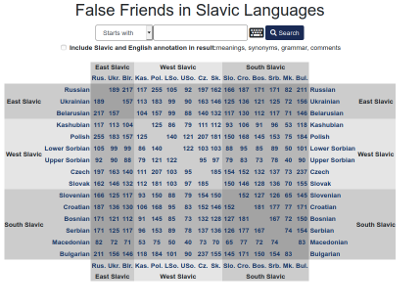Announcements
Announcements
The Portal hosts a new database: "False Friends in Slavic Languages."
The goal with the database is to provide an easy-to-use access to information on interlingual interferences in the Slavic languages. As one will see, there are many similar words among the Slavic languages which do not necessarily have the same semantics (or even, in some cases, have merely opposite meaning).
This kind of relation is often referred to as false friends ('faux amis') between two languages:
In linguistics, the informal term false friends refers to pairs of words in two languages (or in two dialects of the same language) that look and/or sound the same but have different meanings. Also known as false (or deceptive) cognates.
The term false friends (in French, faux amis) was coined by Maxime Koessler and Jules Derocquigny in Les faux amis, ou, les trahisons du vocabulaire anglais (False Friends, or, the Treacheries of English Vocabulary), 1928.
The database is especially useful to prevent to mistranslation and might be of interest to anybody who deals with more than one Slavic language.

Most of the linguistic information is presented in the articles on individual terms for each language. In an article, the particular term is listed with its meanings, followed by similar words and their meanings in other Slavic languages. Every article is rendered with a semasiological map and a matrix of word forms and meanings.
There are two approaches to find the needed information: One is to use the search enginge to find a term or by searching the headwords, meaning descriptions, synonyms, grammatical annotation and comments. The other approach is to use the table shown on the screenshot in order to browse the monolingual or bilingual word lists.
Go to the database False Friends in Slavic Languages
I dag lanceres den nye version af Portalen for Østeuropastudier med nyt design, forbedret struktur og navigation samt enkelte nye ressourcer og funktioner.
Designet er blevet mere overskueligt så de enkelte ressourcer nu er lettere tilgængelige. Udover udseende har portalen fået enkelte forbedringer i strukturen og i indholdet:
- Translitterationsværkøjet til russisk og oldkirkeslavisk er tilgængeligt igen
- Portalen råder nu over et virtuelt tastatur til alle østeuropæiske (og SNG) standardsprog samt oldkirkeslavisk og glagolitisk. I mobilversionen erstatter tastaturet automatisk mobilens indbyggede tastatur så det bliver nemmere at indtaste østeuropæiske bogstaver
- Forbedringer af søgningsfunktionen - især til nyhedskanalerne og linkdatabasen. Det er nu muligt at abonnere på søgningsresultaterne
- Nyhederne er blevet opdateret med adskillige nye, fagrelevante kilder fra de nordiske lande. Se listen her.
- Portalen sætter stor pris på tilgængelighed. Den har fået en tilgængelig version og er bl.a. blevet tilpasset til forenklet brug med skærmlæsere og til navigation vha. tastaturet.
Du kan sammenligne den nye version med den gamle her og her.
Portalen er stadig under udvikling så der er brug for din mening omkring brugervenlighed, tilgængelighed, layout osv. Det vil derfor være en stor hjælp hvis du giver din (gerne også kristiske) mening tilkende.
Læs mere om portalens formål, fokusområde, tilbud, statistikker og funktioner.The Danish Portal for Slavonic Studies offers the possibility to search in the Sorbian Bibliography.
SorBib is maintained by the Sorbian Institute in Bautzen/Budyšin and contains about 74,000 records from 1945 till 2016.
More information on the Sorbian people and their Slavic language is available in the link database » Sorbian.
Another three etymological dictionaries of Russian have been published on the diacronic dictionary system:
- Н. М. Шанский. Школьный этимологический словарь русского языка (6,281 headwords)
- Г. П. Цыганенко. Этимологический словарь русского языка (3,698 headwords)
- М.Н. Свиридова. Этимологический словарь современного русского языка (6,015 headwords)
The system now contains about 123,000 headwords.
The diacronic dictionary system of this portal publishes today a new OCS-Russian dictionary containing 38,000 headwords. The dictionary system now comprises a total amount of 108,000 headwords.
The dictionary system of the Portal for East European Studies has a new dictionary on linguistic terms for English, German, Russian and Serbocroatian. All 2,600 headwords are annotated thematically.
